steering wheel Alfa Romeo 8C 2009 Owner handbook (in English)
[x] Cancel search | Manufacturer: ALFA ROMEO, Model Year: 2009, Model line: 8C, Model: Alfa Romeo 8C 2009Pages: 223, PDF Size: 14.35 MB
Page 7 of 223
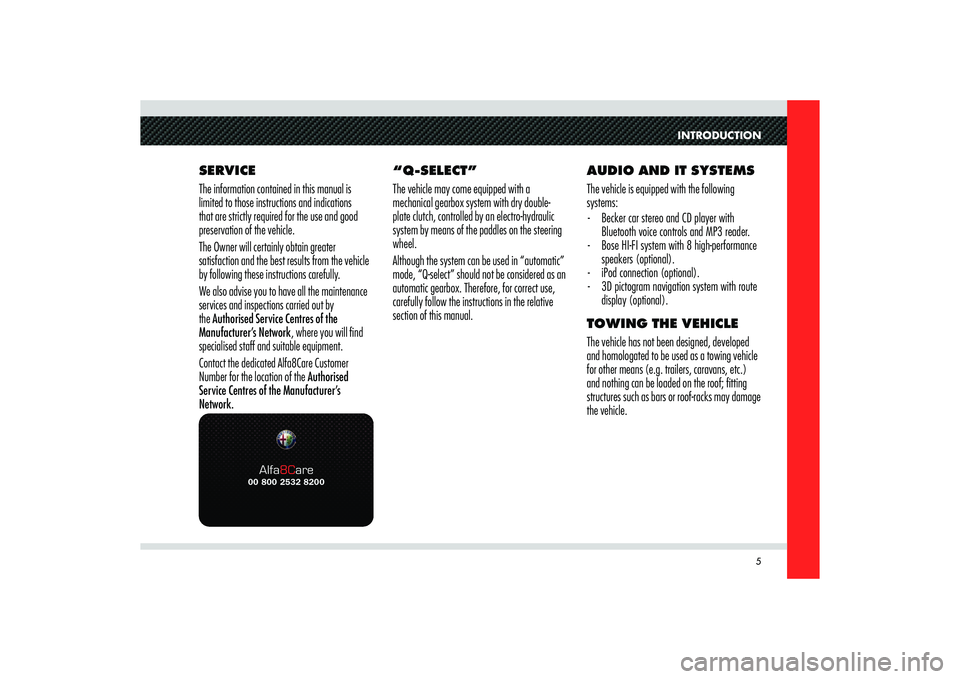
00 800 2532 8200Alfa8Care
INTRODUCTION
5
SERVICE
The information contained in this manual is
limited to those instructions and indications
that are strictly required for the use and good
preservation of the vehicle.
The Owner will certainly obtain greater
satisfaction and the best results from the vehicle
by following these instructions carefully.
We also advise you to have all the maintenance
services and inspections carried out by
the Authorised Service Centres of the
Manufacturer’s Network, where you will fi nd
specialised staff and suitable equipment.
Contact the dedicated Alfa8Care Customer
Number for the location of the Authorised
Service Centres of the Manufacturer’s
Network.“Q-SELECT”
The vehicle may come equipped with a
mechanical gearbox system with dry double-
plate clutch, controlled by an electro-hydraulic
system by means of the paddles on the steering
wheel.
Although the system can be used in “automatic”
mode, “Q-select” should not be considered as an
automatic gearbox. Therefore, for correct use,
carefully follow the instructions in the relative
section of this manual.AUDIO AND IT SYSTEMS
The vehicle is equipped with the following
systems:
- Becker car stereo and CD player with
Bluetooth voice controls and MP3 reader.
- Bose HI-FI system with 8 high-performance
speakers (optional).
- iPod connection (optional).
- 3D pictogram navigation system with route
display (optional).
TOWING THE VEHICLE
The vehicle has not been designed, developed
and homologated to be used as a towing vehicle
for other means (e.g. trailers, caravans, etc.)
and nothing can be loaded on the roof; fi tting
structures such as bars or roof-racks may damage
the vehicle.
Page 30 of 223
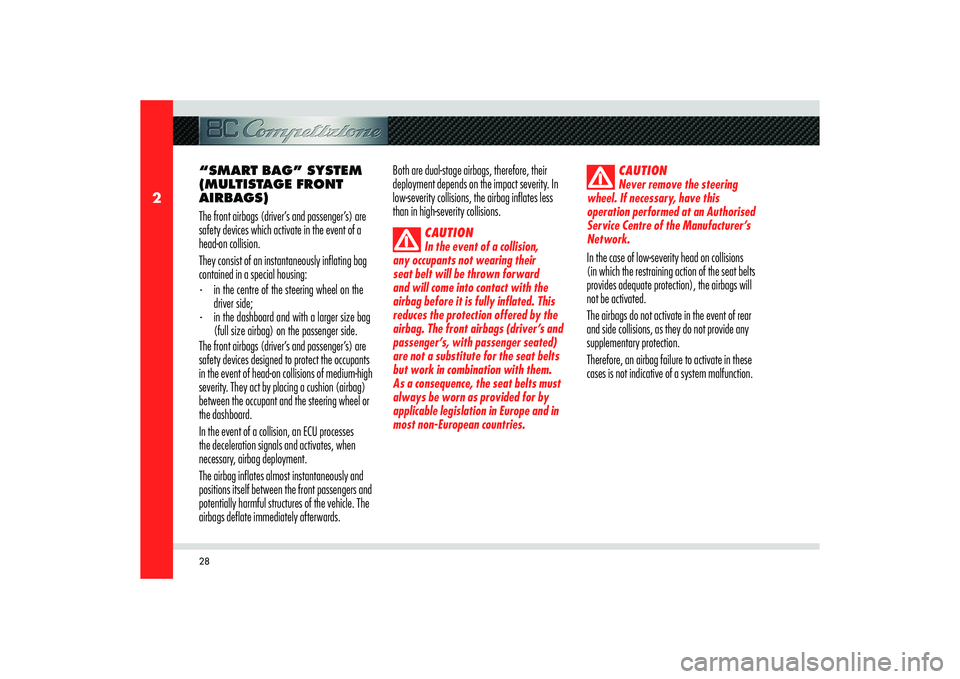
28
2
CAUTION
Never remove the steering
wheel. If necessary, have this
operation performed at an Authorised
Service Centre of the Manufacturer’s
Network.
In the case of low-severity head on collisions
(in which the restraining action of the seat belts
provides adequate protection), the airbags will
not be activated.
The airbags do not activate in the event of rear
and side collisions, as they do not provide any
supplementary protection.
Therefore, an airbag failure to activate in these
cases is not indicative of a system malfunction. “SMART BAG” SYSTEM
(MULTISTAGE FRONT
AIRBAGS)
The front airbags (driver’s and passenger’s) are
safety devices which activate in the event of a
head-on collision.
They consist of an instantaneously inflating bag
contained in a special housing:
- in the centre of the steering wheel on the
driver side;
- in the dashboard and with a larger size bag
(full size airbag) on the passenger side.
The front airbags (driver’s and passenger’s) are
safety devices designed to protect the occupants
in the event of head-on collisions of medium-high
severity. They act by placing a cushion (airbag)
between the occupant and the steering wheel or
the dashboard.
In the event of a collision, an ECU processes
the deceleration signals and activates, when
necessary, airbag deployment.
The airbag inflates almost instantaneously and
positions itself between the front passengers and
potentially harmful structures of the vehicle. The
airbags deflate immediately afterwards.Both are dual-stage airbags, therefore, their
deployment depends on the impact severity. In
low-severity collisions, the airbag inflates less
than in high-severity collisions.
CAUTION
In the event of a collision,
any occupants not wearing their
seat belt will be thrown forward
and will come into contact with the
airbag before it is fully inflated. This
reduces the protection offered by the
airbag. The front airbags (driver’s and
passenger’s, with passenger seated)
are not a substitute for the seat belts
but work in combination with them.
As a consequence, the seat belts must
always be worn as provided for by
applicable legislation in Europe and in
most non-European countries.
Page 31 of 223
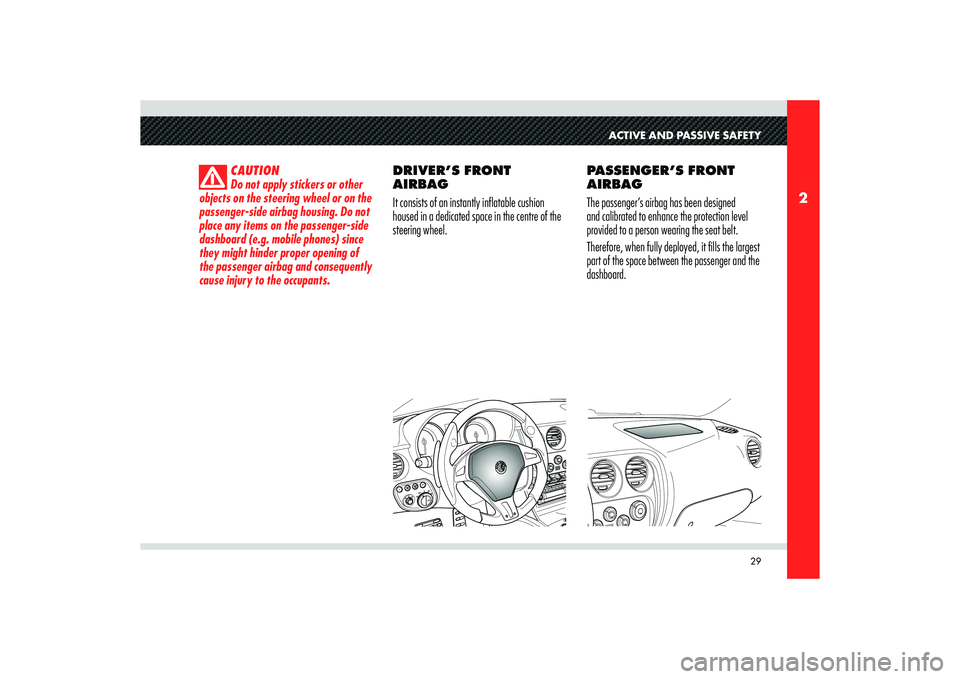
29
2
ACTIVE AND PASSIVE SAFETY
CAUTION
Do not apply stickers or other
objects on the steering wheel or on the
passenger-side airbag housing. Do not
place any items on the passenger-side
dashboard (e.g. mobile phones) since
they might hinder proper opening of
the passenger airbag and consequently
cause injury to the occupants.
DRIVER’S FRONT
AIRBAG
It consists of an instantly inflatable cushion
housed in a dedicated space in the centre of the
steering wheel.PASSENGER’S FRONT
AIRBAG
The passenger’s airbag has been designed
and calibrated to enhance the protection level
provided to a person wearing the seat belt.
Therefore, when fully deployed, it fills the largest
part of the space between the passenger and the
dashboard.
Page 34 of 223
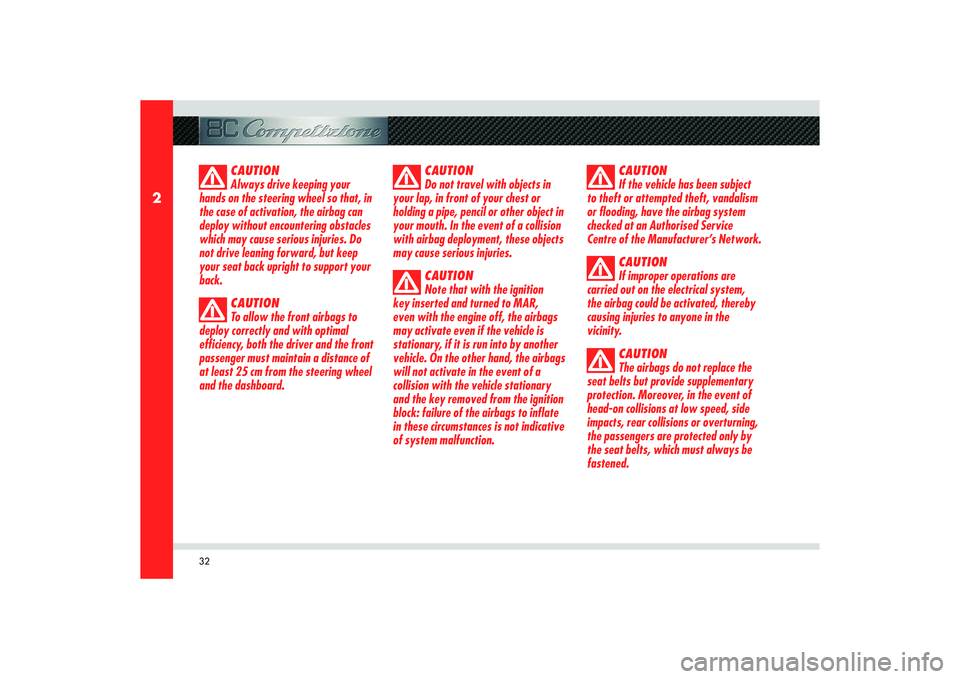
32
2
CAUTION
Always drive keeping your
hands on the steering wheel so that, in
the case of activation, the airbag can
deploy without encountering obstacles
which may cause serious injuries. Do
not drive leaning forward, but keep
your seat back upright to support your
back.
CAUTION
To allow the front airbags to
deploy correctly and with optimal
efficiency, both the driver and the front
passenger must maintain a distance of
at least 25 cm from the steering wheel
and the dashboard.
CAUTION
Do not travel with objects in
your lap, in front of your chest or
holding a pipe, pencil or other object in
your mouth. In the event of a collision
with airbag deployment, these objects
may cause serious injuries.
CAUTION
Note that with the ignition
key inserted and turned to MAR,
even with the engine off, the airbags
may activate even if the vehicle is
stationary, if it is run into by another
vehicle. On the other hand, the airbags
will not activate in the event of a
collision with the vehicle stationary
and the key removed from the ignition
block: failure of the airbags to inflate
in these circumstances is not indicative
of system malfunction.CAUTION
If the vehicle has been subject
to theft or attempted theft, vandalism
or flooding, have the airbag system
checked at an Authorised Service
Centre of the Manufacturer’s Network.
CAUTION
If improper operations are
carried out on the electrical system,
the airbag could be activated, thereby
causing injuries to anyone in the
vicinity.
CAUTION
The airbags do not replace the
seat belts but provide supplementary
protection. Moreover, in the event of
head-on collisions at low speed, side
impacts, rear collisions or overturning,
the passengers are protected only by
the seat belts, which must always be
fastened.
Page 45 of 223
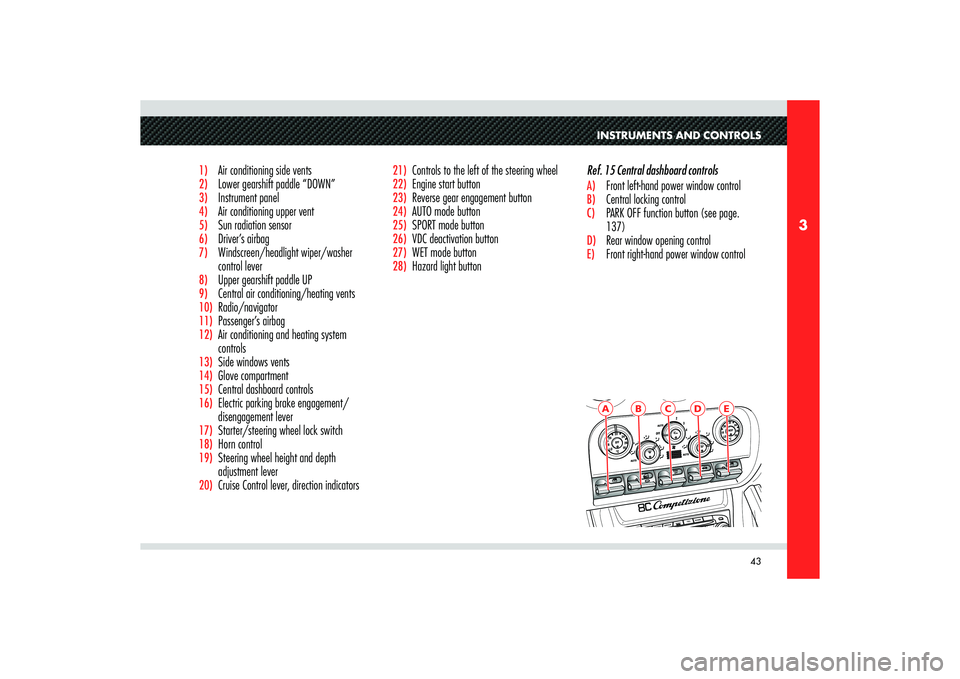
43
3
A
B
C
D
E
INSTRUMENTS AND CONTROLS
1) Air conditioning side vents2) Lower gearshift paddle “DOWN”3) Instrument panel4) Air conditioning upper vent5)
Sun radiation sensor
6)
Driver’s airbag
7)
Windscreen/headlight wiper/washer
control lever
8)
Upper gearshift paddle UP
9)
Central air conditioning/heating vents
10)
Radio/navigator
11)
Passenger’s airbag
12)
Air conditioning and heating system
controls
13)
Side windows vents
14)
Glove compartment
15)
Central dashboard controls
16)
Electric parking brake engagement/
disengagement lever
17)
Starter/steering wheel lock switch
18)
Horn control
19)
Steering wheel height and depth
adjustment lever
20)
Cruise Control lever, direction indicators
21)
Controls to the left of the steering wheel
22)
Engine start button
23)
Reverse gear engagement button
24)
AUTO mode button
25)
SPORT mode button
26)
VDC deactivation button
27)
WET mode button
28)
Hazard light buttonRef. 15 Central dashboard controls
A) Front left-hand power window controlB) Central locking control C) PARK OFF function button (see page.
137)D) Rear window opening control E) Front right-hand power window control
Page 46 of 223
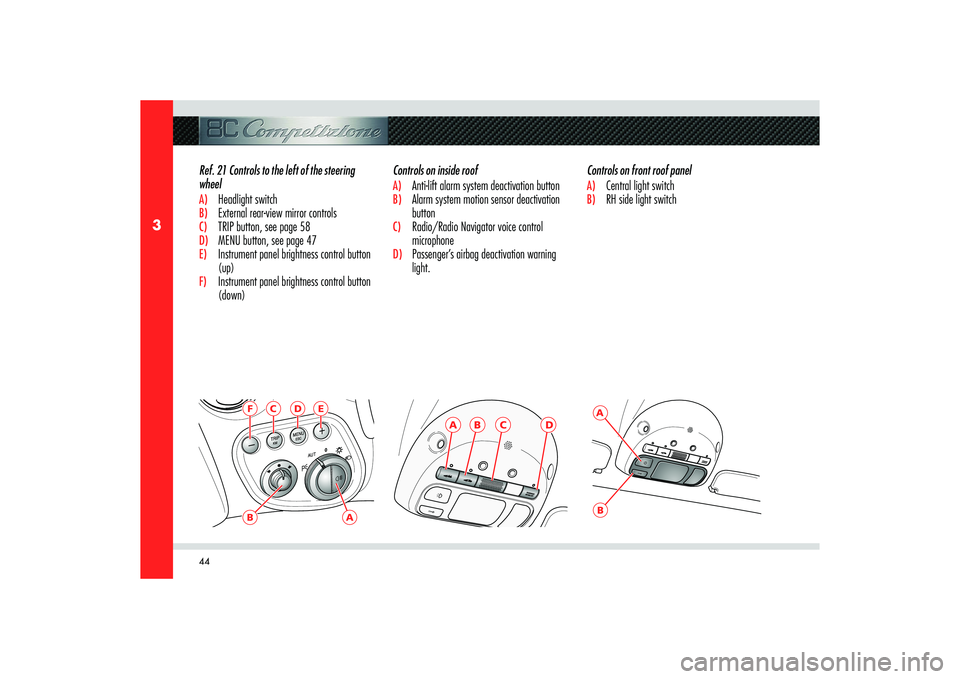
44
3
A
B
C
D
F
C
D
E
B
A
AB
Controls on inside roofA) Anti-lift alarm system deactivation buttonB) Alarm system motion sensor deactivation
buttonC) Radio/Radio Navigator voice control
microphoneD) Passenger’s airbag deactivation warning
light. Ref. 21 Controls to the left of the steering
wheel
A) Headlight switchB) External rear-view mirror controlsC) TRIP button, see page 58D) MENU button, see page 47E) Instrument panel brightness control button
(up)F) Instrument panel brightness control button
(down)Controls on front roof panel
A) Central light switchB) RH side light switch
Page 60 of 223
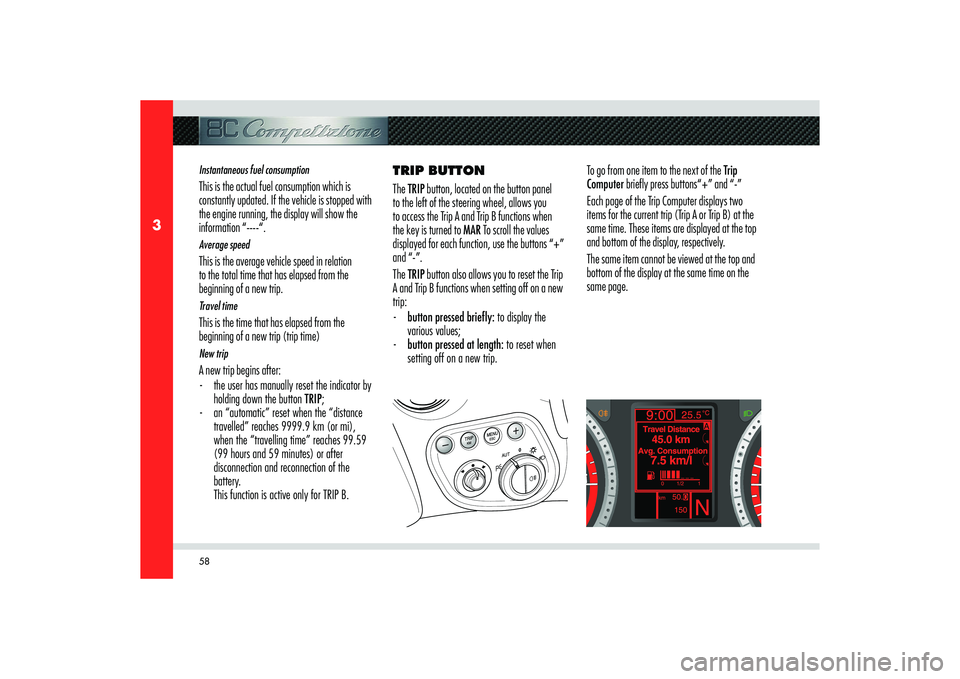
58
3
Instantaneous fuel consumptionThis is the actual fuel consumption which is
constantly updated. If the vehicle is stopped with
the engine running, the display will show the
information “----“.Average speedThis is the average vehicle speed in relation
to the total time that has elapsed from the
beginning of a new trip.Travel timeThis is the time that has elapsed from the
beginning of a new trip (trip time) New tripA new trip begins after:
- the user has manually reset the indicator by
holding down the button TRIP;
- an “automatic” reset when the “distance
travelled” reaches 9999.9 km (or mi),
when the “travelling time” reaches 99.59
(99 hours and 59 minutes) or after
disconnection and reconnection of the
battery.
This function is active only for TRIP B.TRIP BUTTON
The TRIP button, located on the button panel
to the left of the steering wheel, allows you
to access the Trip A and Trip B functions when
the key is turned to MAR To scroll the values
displayed for each function, use the buttons “+”
and “-”.
The TRIP button also allows you to reset the Trip
A and Trip B functions when setting off on a new
trip:
- button pressed brie� y: to display the
various values;
- button pressed at length: to reset when
setting off on a new trip.To go from one item to the next of the Trip
Computer briefly press buttons“+” and “-”
Each page of the Trip Computer displays two
items for the current trip (Trip A or Trip B) at the
same time. These items are displayed at the top
and bottom of the display, respectively.
The same item cannot be viewed at the top and
bottom of the display at the same time on the
same page.
Page 71 of 223
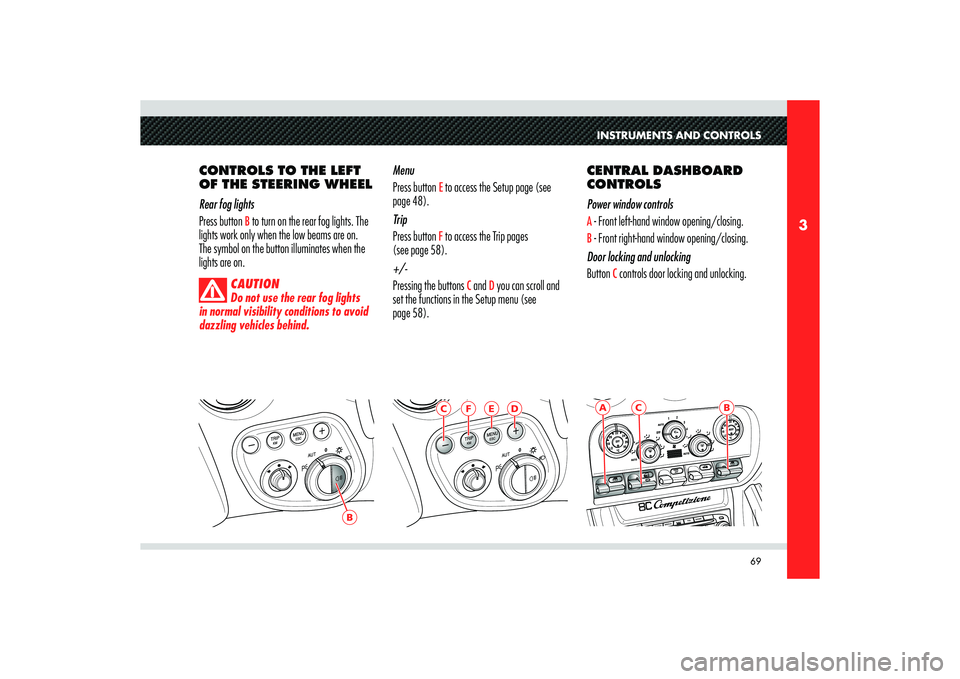
69
3
B
C
B
AINSTRUMENTS AND CONTROLS
CONTROLS TO THE LEFT
OF THE STEERING WHEEL
Rear fog lights
Press button
B to turn on the rear fog lights. The
lights work only when the low beams are on.
The symbol on the button illuminates when the
lights are on.
CAUTION
Do not use the rear fog lights
in normal visibility conditions to avoid
dazzling vehicles behind.
Menu
Press button
E to access the Setup page (see
page 48).
Trip
Press button F to access the Trip pages
(see page 58).
+/-
Pressing the buttons
C and
D you can scroll and
set the functions in the Setup menu (see
page 58).CENTRAL DASHBOARD
CONTROLS
Power window controls
A - Front left-hand window opening/closing.B - Front right-hand window opening/closing.
Door locking and unlocking
Button
C controls door locking and unlocking.
E
F
C
D
Page 79 of 223
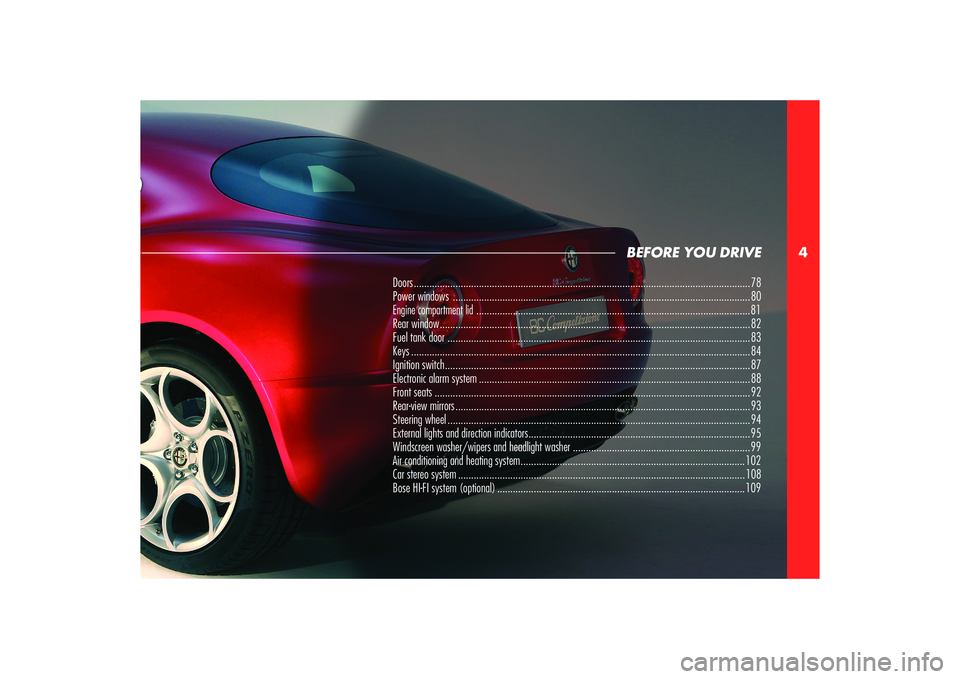
4
BEFORE YOU DRIVE
Doors ................................................................................................................................. 78
Power windows .................................................................................................................. 80Engine compartment lid
......................................................................................................... 81
Rear window ....................................................................................................................... 82
Fuel tank door .................................................................................................................... 83
Keys .................................................................................................................................. 84
Ignition switch ..................................................................................................................... 87
Electronic alarm system ........................................................................................................88
Front seats ......................................................................................................................... 92
Rear-view mirrors ................................................................................................................. 93
Steering wheel .................................................................................................................... 94
External lights and direction indicators ..................................................................................... 95
Windscreen washer/wipers and headlight washer .................................................................... 99
Air conditioning and heating system ...................................................................................... 102
Car stereo system .............................................................................................................. 108
Bose HI-FI system (optional) ............................................................................................... 109
Page 89 of 223
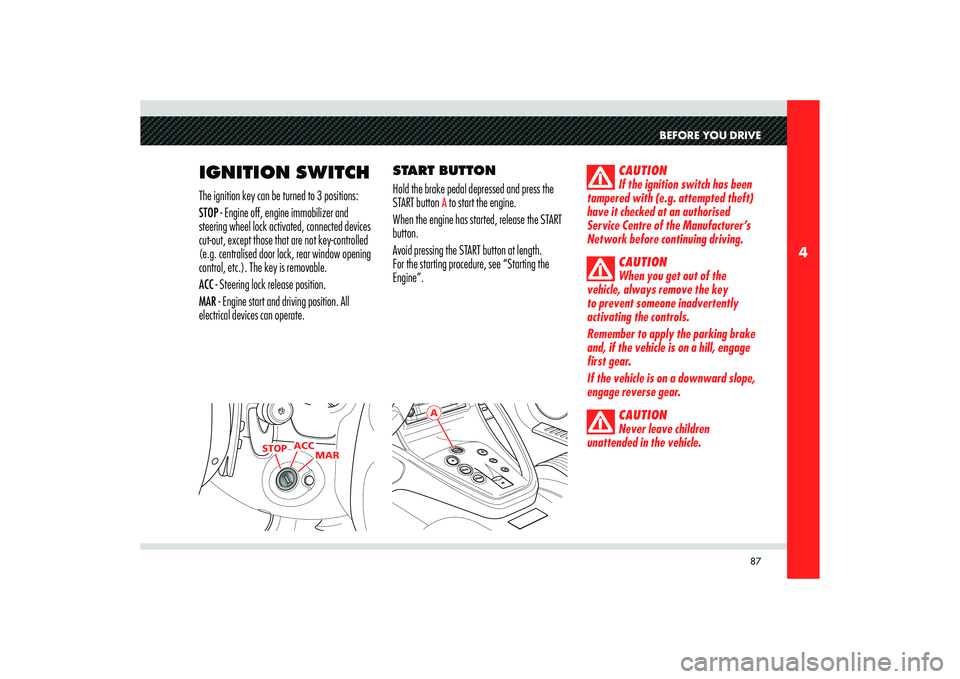
87
4
STOPACC
MAR
A
BEFORE YOU DRIVE
IGNITION SWITCHThe ignition key can be turned to 3 positions:
STOP - Engine off, engine immobilizer and
steering wheel lock activated, connected devices
cut-out, except those that are not key-controlled
(e.g. centralised door lock, rear window opening
control, etc.). The key is removable.
ACC - Steering lock release position.
MAR - Engine start and driving position. All
electrical devices can operate.START BUTTON
Hold the brake pedal depressed and press the
START button
A to start the engine.
When the engine has started, release the START
button.
Avoid pressing the START button at length.
For the starting procedure, see “Starting the
Engine”.
CAUTION
If the ignition switch has been
tampered with (e.g. attempted theft)
have it checked at an authorised
Service Centre of the Manufacturer’s
Network before continuing driving.
CAUTION
When you get out of the
vehicle, always remove the key
to prevent someone inadvertently
activating the controls.
Remember to apply the parking brake
and, if the vehicle is on a hill, engage
first gear.
If the vehicle is on a downward slope,
engage reverse gear.
CAUTION
Never leave children
unattended in the vehicle.